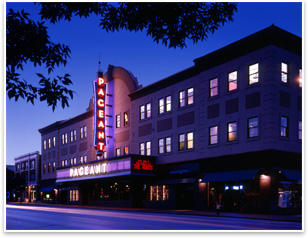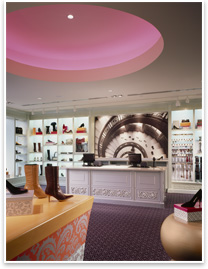From Project Diversity to People Diversity
When it comes to judging the needs of the contemporary cosmopolitan consumer, Kiku Obata doesn’t have to look much further than her own diverse and interdisciplinary staff
by Zach Mortice
Associate Editor
How do you . . . create a design practice that draws demographic diversity from diverse project types?
Summary: For Kiku Obata, Assoc. AIA, and her eponymous design firm, a demographically and interdisciplinary staff is the best resource for interpreting the contemporary consumer’s wants and desires for the commercial clients for whom they design. The firm (50 percent female, 30 percent minority, with a wide range of ages) pulls together its staff in focus groups and charrettes that take advantage of the wide array or cultures across the office in order to predict the lifestyle preferences and commercial sensibilities of their clients’ customers.
 The
Pageant in the Delmar Loop, a concert venue and home to Kiku Obata
and Company’s offices, which they designed.
Their multidisciplinary range of expertise means that they can spread this knowledge across all scales of design on any project, like their work on downtown St. Louis’s burgeoning residential urban living destination, the Washington Avenue Loft District, where they came up with planning guidelines for the streetscapes, planned parking and public space uses, designed street lighting, and even created the area’s distinct, industrial I-beam signage. Obata says her goal was to create an exciting urban experience that would attract a generation of 20-somethings to reclaim downtown St. Louis for habitation. Closer to their own neighborhood in St. Louis’s Delmar Loop area (a vibrant commercial and cultural corridor next to Washington University), Kiku Obata and Company have consulted on streetscape design guidelines and designed buildings and their interiors, lighting, graphics, and signage—often assembling commercial retailer’s entire brand identity from these elements.
“We really look at what the position is for anything we do,” Obata says. “What does this mean to whom? Who is this important to? What is important to them? What should this place mean to them? “We get a diversity of people here because we want our culture to reflect that culture that’s in the everyday environment in which we work,” she says.
 Kiku
Obata and Company’s Ciella, a shoe store in Kansas City,
Kan.
Branding ‘A to Z’
Obata’s 28-person, St. Louis-based firm works for many large commercial and retail clients (Starbucks, Whole Foods, The St. Louis Cardinals) as well as smaller boutique retailers. The firm’s diverse demographics are grounded in an interdisciplinary practice culture that offers architecture, interior design, branding strategies, lighting, industrial design, and graphic design for the Web, print, and signage. They even have a staff writer.
This wide and integrated array of expertise means that Kiku Obata and Company can take clients through the entire spectrum of built environment design—environmental graphic design to planning entire neighborhoods. “What is unique is that we can go to a company and say, ‘We can create your brand from A to Z,’” says Kevin Flynn, AIA, vice president of Kiku Obata and Company.
This holistic, consumer-centered design approach is all organized by project rather than discipline. Projects aren’t owned by any single design discipline, and all disciplines are assigned to projects as equal collaborative partners. “In the past, an architect may think that he or she should be the one coming up with the big idea for an architectural project, but in this case, it may be that a graphic designer throws out an idea that the architect will have to interpret,” says Flynn. “We really encourage that teamwork and collaboration.”
 Kiku
Obata and Company’s Big Shark Bicycle Company St. Louis’s
Delmar Loop.
Carla Cruz (who maintains the firm’s resource library, assists other designers in materials selection, and works on interior design projects) says that the firm’s non-hierarchical management and practice model means decisions are open to all, and that younger designers can’t just defer to elders and assume they’ll call all the shots. “It really pushes everyone to get out of their seat and talk and ask questions,” she says.
Culture and context
This collaborative, multidisciplinary approach helps to attract a diverse range of designers, says Obata, herself a Japanese-American and the daughter of storied Modernist architect Gyo Obata, FAIA, a founder of HOK. By ensuring that they have a diverse staff that reflects the contemporary, cosmopolitan marketplace, Kiku Obata and Company have a clearer window into a wide range of customer cultures. “Our culture here reflects the culture of [clients’] users,” she says.
“I’ve been in other firms early in my career where it wasn’t [this diverse], and what you find is that you walk away from meetings with everybody almost saying the same thing,” says Russell Buchanan, an interior designer and team leader with the firm. “That’s nice and cushy and comfortable, but that’s probably not the real world.”
Buchanan says honest dialogue allows them to better navigate how different consumer groups and cultures interpret different words, languages, and design motifs. “All of that is pretty huge for clients who are trying to maximize their customer base,” he says.
It also allows Obata to contextualize her design decisions for her clients’ customers. “I think that’s really important today,” she says. “In the past so many things were built and just plopped into a context without any sensitivity to what’s going on around it, and I think you need to engage people’s hearts and mind. One way [to do that] is to open up the dialogue. If you open up the dialogue, you get a more diverse audience.”
|





